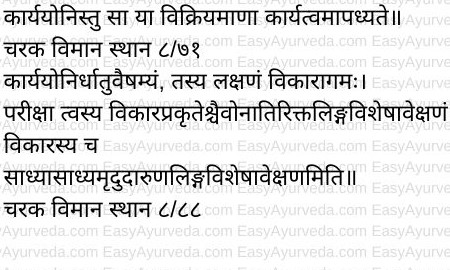By Dr Raghuram Y.S. MD (Ay) & Dr Manasa, B.A.M.S
Karyayoni is the third factor to be examined according to Master Charaka’s ten factors to be examined i.e. dashavidha parikshya bhavas. Karya = action, Yoni = source
We need to understand this in connection and in relation with the previous two factors and the factor succeeding it.
Read – Roga, Rogi Pareeksha: Examination Of Disease And Patient

Table of Contents
The previous 2 factors to be examined are –
Kaarana – i.e. the cause, the physician who is the chief cause in establishing the equilibrium of body components in the patient / person and also in establishing the state of comprehensive health in them.
Karana – means the tools or instruments used by the physician to achieve his action of providing comprehensive health and all approaches made towards it. This includes the medicines used by the doer i.e. physician towards bringing the balance of body components and establishing health in the subjects.
The following factor for Karyayoni is –
Karya – i.e. action, which includes establishing the state of equilibrium of doshas, tissues and excreta in the body
Now we will try to understand the karyayoni in relation to these 3 factors.
Read – 10 Factors Of Patient Examination – Dasha Vidha Atura Pareeksha
Understanding Karyayoni
What is the duty of the physician?
The duty of the physician is to treat the diseases of his patients. For this he would use many kinds of effective medicines as instruments of action (treatment).
So the target of the physician is the disease. In other words the physician targets to correct the imbalances occurring in doshas, tissues and excreta, either individually or all together or relatively. By bringing the balance of these components he would establish health in the subjects.
If treatment or correction of imbalances of doshas, tissues and excreta is the intended action, the imbalances of these components form the source of action. If there are no imbalances where is the need of action to be taken by the physician and on what he would take the action?
To sum up – the imbalanced body components which have caused a diseased state in the patient or ailing individual is the source of action for a physician and hence is considered as karyayoni.
Definition and meaning
Master Charaka defines Karyayoni as –
‘Dhatu vaishamya i.e. the imbalance of the components of the body i.e. doshas, tissues and excreta is itself the source of action (treatment process). This is the main cause for the causation of the disease. This is called Karyayoni’.
Sign of Karyayoni
‘The manifestation of the disease in the body itself is the chief sign of karyayoni’.
Therefore karyayoni is the source of action or area of interest for the physician (kaarana) to operate upon (karya) by effectively using the medicines (karana).
Read – Types Of Doshas And Their Functions
How to examine?
Examination of the karyayoni comprises of examining –
– the causes of the disease
– observing symptoms of the manifested disease and understanding them in a subtle and precise way, immaterial of the symptoms being in less or more quantity
– carefully observing and noting down the curability and incurability (prognosis) of the disease
– carefully observing, noting down and understanding the mild and severe nature of the disease
These factors can be further examined with the tools explained in Ayurveda i.e.
Nidana Panchaka i.e. the knowledge of causative factors, premonitory symptoms, symptoms, palliating and aggravating factors and pathogenesis of disease
Sadhyasadhyata – i.e. the knowledge of curability and incurability of diseases
Read – Relationship Of Doshas With Nidana Panchakas
Sanskrit Verses

Research
The imbalance of body components or a diseased condition is the area of interest for a physician as already said.
When we consider a researcher in place of a physician, a research problem or research question can be considered as a source of action i.e. karyayoni.
Just like the disease is the area of interest for the physician’s action, a research question is the area of interest for a researcher for taking action and thus is the source of action in the research field.
Selection and defining a research problem is the first and foremost step for a researcher to take in the research process. After finding out the problem, the researcher should formulate the problem in such a way that it becomes the subject of research.
Read – Chikitsa: Treatment Types, Ayurvedic classification
So, what is a research problem?
Research problem is a question for which the researcher seeks an answer or makes a hypothetical answer which forms the basis of good research. Just like the physician seeks a disease process in the patient, makes a diagnosis and considers it suitable for implementation of action i.e. treatment.
A research problem usually refers to ‘some difficulty’ / ‘problem’ experienced by a researcher. This problem may be encountered in the context of a theoretical or practical situation. This will motivate the researcher to find a solution for the potential problem he has in his view.
The problem should be the one which should compel a researcher to find the best solution for a given problem. It should compel him or drive him to find out the best course of action so as to achieve his objective as far as a given problem is considered in a given environment.
Need for properly defining the research problem – Researchers should properly define the research problem. This will keep him motivated in the right direction of research work. Just like a physician should be able to clearly diagnose and define a given disease so that he can give appropriate treatment and medicine. If the problem is not defined properly the research process will be in trouble.
Formulation of hypothesis – It is one of the major steps in planning the research work. This too shall be considered as karyayoni. Before starting the research one should make a proper hypothesis. It is a predictive statement. This statement is capable of being tested by scientific methods. This is the key and mandatory step. Formulating a proper hypothesis provides a suitable platform for studying the problem with keen focus. It states what specific aspects of a research problem should be investigated, what type of data needs to be collected and what not. This provides proper direction and focus for the future study. The construction of a hypothesis enhances objectivity in a study.
Click to Consult Dr Raghuram Y.S. MD (Ayu)









